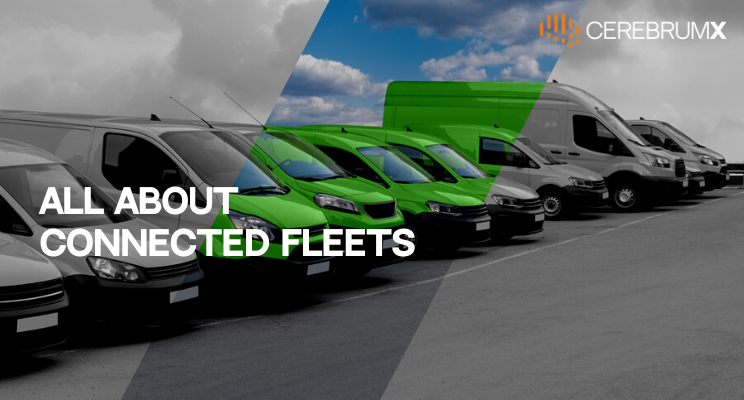Wondering what Connected fleets & Connected vehicles are? The 21st century automotive industry is moving towards a new and more connected ecosystem, which focuses on the all-around development of each and every clog in the transportation wheel. When it comes to fleet management, what has always been a set of unidirectional efforts aimed at maximizing fleet outputs, is slowly taking a turn towards connected fleets that are based on the principle of two-way communication and effective vehicle feedback.
What are Connected Vehicles?
Connected cars are vehicles that consist of IoT connectivity and use it to access the internet through in-built capabilities. Offering smart features to the driver, connected vehicles constantly collect user data across a range of parameters, and share them on the cloud for further analysis.
Connected vehicles come equipped with a host of onboard sensors, that collect connected car data and help with enhancing the overall driving and ownership experience. The connected vehicle technology forms the basis for the revolutionary self-driving and autonomous cars, and supports connectivity across the auto sector, from fleets to EVs.
What are Connected Fleets?
Based on the concept of connected cars, connected fleets represent the modern-day fleet vehicles, capable of communicating with other connected vehicles, and pedestrians as well as a centrally designated infrastructure. Nurturing a connection with the usage patterns, surroundings, and back-office operations, connected fleets allow a high-level overview of the entire operations. The integration of business with fleet also brings order to the set goals and efficiencies, that make way for monitoring, analyzing, and automating the connected fleet vehicles.
What is the role of Connected Vehicle Data & Telematics in connected fleets?
When it comes to connectivity in fleets, the focus has been traditionally targeted at collecting data from fleet vehicles using third-party apps and OBD devices. It would then be shared with fleet managers and service providers to enable smart decision-making. The current revolution of fleet connectivity brings digitization to the fleet management ecosystem. Data is collected directly by the vehicle, and in turn by the OEMs, stored in a cloud-based platform, and retrieved for specific business purposes.
As a result, fleet vehicles evolve into an active resource across the entire value chain, acting as live data beacons that open new opportunities to manage not just the vehicles but also drivers, assets, and business competencies. Fleet telematics enable fleet managers to implement data-driven strategies that reduce overall costs, improve uptime and boost driver safety with real-time visibility.
How Connected Vehicle Technology strengthens fleet management?
An array of onboard sensors capture every ounce of data, from vehicle speed, live location, and engine status, to vehicle vitals, tire pressure, driver behavior, and overall performance. Data is also gathered from collisions and the vehicle environment, such as traffic volume and road congestion, all of which enable fleet managers to extract key improvement areas.
Connected vehicle technology ensures quick and easy access to all this data, without the mediator of aftermarket devices, which not just makes the data collection accurate but also superior in quality. The data is directly captured by the OEM and shared on request with the customers, based on proper authentication through VINs. Once fed into a connected vehicle data management software similar to the likes of CEREBRUMX, cloud-based features present simplified dashboards and quickly generate reports.
What are some advantages of the Connected Fleet business model?
Connected fleets have transformed fleet management operations by enabling managers to manage their fleets remotely. Real-time visibility into a range of parameters, including fuel consumption, temperature, service history, and more, has led to newer business models with higher efficiency.
-
Fleet Tracking
Real-time fleet tracking has been made possible by constantly trans-receiving the vehicle’s live location via GPS signals, and staying up to date on the fleet’s activities and status. Tracking fleets has been proven to boost productivity across fleets, by minimizing downtime and rerouting vehicles in line with traffic flow.
-
Reducing Costs
Connected fleets carry the ability to send alerts, in real-time, for low fuel levels, missed and upcoming maintenance appointments, and other crucial parameters. Proactively tending to each of these areas could help save potential breakdowns and incurred costs.
-
Maintaining Drive Safety
Fleet telematics provide visibility into the driving behavior as well as the live vehicle status, which proves to be a powerful tool in ensuring utmost driver safety. While managers can easily identify and discourage risky driving behavior, such as speeding and sharp cornering, they can also send help exactly where it’s needed, in the event of an accident.
-
Fleet Electrification
Connected fleets have also been able to open new opportunities for fleet operators by inculcating the latest in the auto industry. Intelligent analysis of fleet data and battery performance yields smart insights that allow for the shift to electric fleets and sustainable charging infrastructure.
Connected fleets are all about connected vehicle data. Data, that powers a new range of services while optimizing the everyday fleet operations, and gives rise to valuable insights aimed at delivering high-quality services. To know more about connected vehicle data and how you can unlock the value behind data, visit www.cerebrumx.ai.

